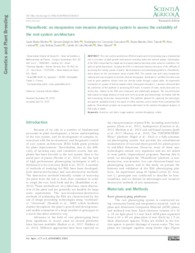PhenoRoots: an inexpensive non-invasive phenotyping system to assess the variability of the root system architecture.
PhenoRoots: an inexpensive non-invasive phenotyping system to assess the variability of the root system architecture.
Author(s): MARTINS, S. M.; BRITO, G. G. de; GONCALVES, W. da C.; TRIPODE, B. M. D.; LARTAUD, M.; DUARTE, J. B.; MORELLO, C. de L.; GIBAND, M.
Summary: The root system architecture (RSA) of plants and its functioning play a fundamental role in a number of plant growth mechanisms including water and nutrient uptake. Optimization of the RSA is important for stable and increased plant productivity under adverse conditions. Despite its great importance, studying the RSA is notoriously laborious because of the difficulty of accessing the rooting system of plants. We developed a root phenotyping platform, PhenoRoots, which allows for the non-invasive study of plant RSA. The system was built using inexpensive material and was designed to provide medium throughput. Substrate-or soil-filled rhizotrons are used to grow plantlets, whose roots are directly visible through a glass plate. An experiment conducted on a panel of twenty Upland cotton (Gossypium hirsutum L.) varieties demonstrated the usefulness of the platform in assessing RSA traits. A number of traits, destructive and nondestructive, related to the RSA were measured and statistically analyzed. The non-destructive traits based on image analysis of roots were more accurate and showed high correlation with the time-consuming destructive measurements. The platform allowed for capturing the phenotypic and genetic variability found in the panel of cotton varieties, and to define three contrasting RSA patterns. PhenoRoots provides an inexpensive alternative to the medium throughput analysis of RSA traits in plants.
Publication year: 2020
Types of publication: Journal article
Unit: Embrapa Cotton
Keywords: Cotton, Image analysis, Medium-throughput, Rhizotron, Root traits
Observation
Some of Embrapa's publications are published as ePub files. To read them, use or download one of the following free software options to your computer or mobile device. Android: Google Play Books; IOS: iBooks; Windows and Linux: Calibre.
Access other publications
Access the Agricultural Research Database (BDPA) to consult Embrapa's full library collection and records.
Visit Embrapa Bookstore to purchase books and other publications sold by Embrapa.

